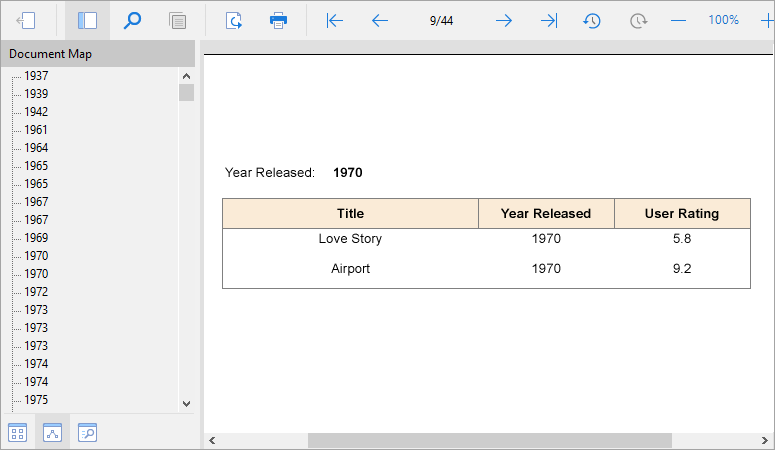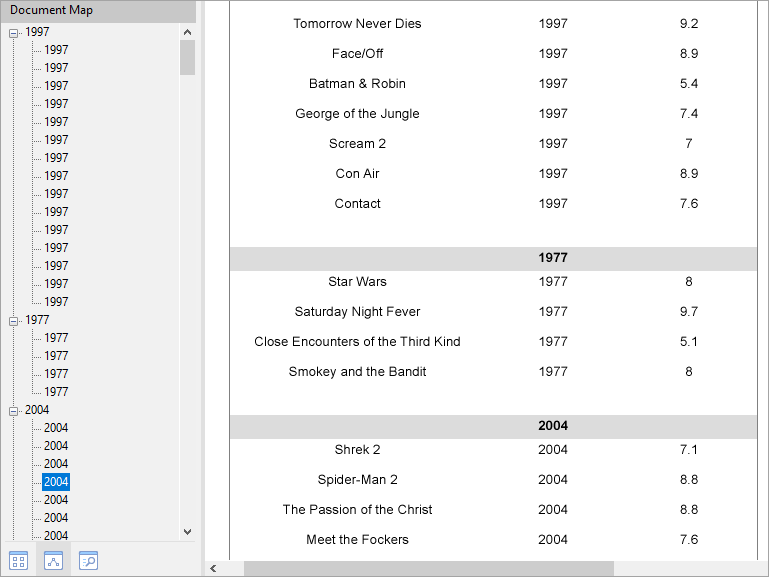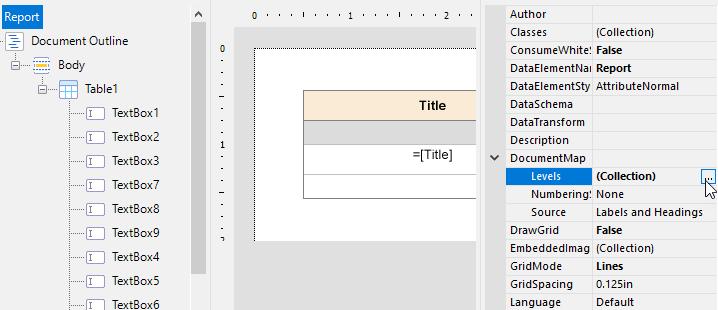In This Topic
When you click an item in the document map, the viewer jumps to that item in the report.
A document map functions as a table of contents and provides a convenient way to navigate a lengthy report.
In a Page or an RDLX report, you can add report controls, data regions, groups and detail groups to the document map by:
- Assigning a value to the Document map label on the Navigation page of the corresponding dialog.
- Setting the value of the Label property in the properties window.
- Setting the value of the HeadingLevel property in the properties window.
Viewing the Document Map
- On the Viewer toolbar, click the Side Panel button to display the sidebar.

- At the bottom of the sidebar pane, click the Document map button to display the document map.

If there is no document map associated with the report, the button does not appear at the bottom of the sidebar pane.
- In the Document map that appears, click the item you want to view in the report.
Exporting Document Map
At preview, the document map appears in a sidebar to the left of the report, but when you export your report to various file formats, they handle document maps differently.
| Export Filter |
Effect on Document Map |
| HTML |
A .toc file containing the document map is exported along with the HTML report. |
| PDF |
Document map appears in the bookmarks panel. |
| Text |
Document map does not appear in the exported report. |
| Rich Text Format |
Document map does not appear in the exported report. |
| TIFF |
Document map does not appear in the exported report. |
| Excel |
Document map does not appear in the exported report. |
Note: For printing and rendering purposes use
Table of Contents control in your Page report and RDLX report.
To add a control to the Document Map
Using Document Map Label or Label Property
- On the design surface, select a control you want to add to the Document map and right-click to choose Properties from the context menu.
- In the command section of the Properties Panel, click the Property dialog open the control's dialog.
- In the dialog that appears, go to the Navigation page and under the Document map label, enter a text or an expression representing the control in the Document map.
Alternatively,
- On the design surface, select the report control you want to add to the Document map and right-click to choose Properties from the context menu.
- In the Properties window that appears, enter a text or an expression in the Label property to represent the report control in the Document map.
Using HeadingLevel Property
- On the design surface, select the report control you want to add to the Document map (e.g. TextBox).
- In the Properties window that appears, set the HeadingLevel property of the report control.
Note The HeadingLevel property defines the DocumentMap level for that control.
- Preview the report to view the document map.

To create a hierarchical Document Map
- Open a report that contains a data region like a Table.
- Select the data region and in the Properties Panel that appears, select the Property dialog command at the bottom of the window to open the data region dialog.
- On the data region dialog, on the Groups page, set the grouping expression. For example, group the data on YearReleased (=Fields!YearReleased.Value).
- On the same Groups page, set the Document map label to the value of the grouping expression. For example, =Fields!YearReleased.Value.
- On the design surface, select a control inside the data region. For example, the TextBox in the detail row of the Table data region.
- Right-click the control and select properties to open the Properties Panel. In the command section of the Properties Panel, click Property dialog.
- In the dialog that appears, go to the Navigation page and under the Document map label, enter a text or an expression representing the control in the Document map.
- Preview the report to view the document map.

Note: In an Page report, you can also set grouping and set the document map label on the FixedPage dialog > Groups page.
To set the numbering style for Document Map levels
You can the set the numbering style for all document map levels using the Report dialog or in the Properties Panel using the DocumentMap property.
- In the Report Explorer select the Report item.
- In the command section of the Properties Panel, click Property dialog to open the Report dialog.
- In the Report dialog that appears, go to the Document Map page and set the Source property to one of the available value.
- Set the Numbering Style to one of the available formats. The selected style would get applied to all the document levels and only to the selected source that you had set above.
- Click OK to close the dialog.
You can also set separate numbering style to different document map levels using the DocumentMapLevelDesigner Collection Editor dialog.
- In the Report Explorer select the Report item.
- Go to the Properties Panel, click the Levels (Collection) property and then click the ellipsis button that appears.

- In the DocumentMapLevelDesigner Collection Editor dialog that appears, consider the hierarchy of report bookmarks that appears in Document Map and add as many levels required using the Add button.
- Select each level and set its NumberingStyle to any of the available format.
- Click OK to close the dialog.
Note: Any customization made here gets directly applied to the
Table of Contents control.



